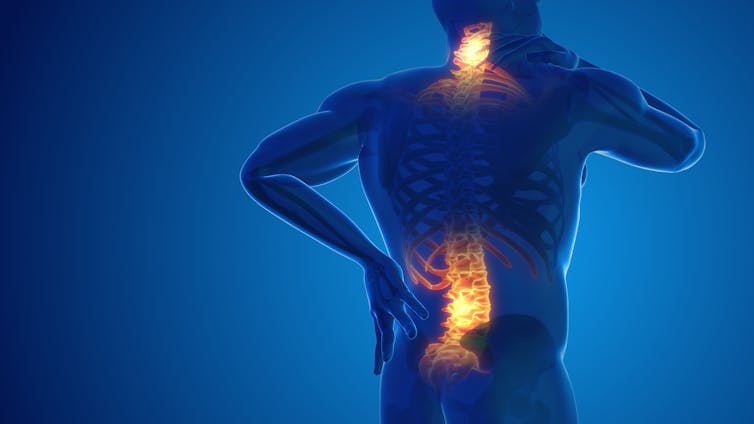
Hundreds of millions of people around the world experience chronic pain – meaning pain that lasts longer than three months. While the numbers vary from country to country, most studies estimate that about 10% of the global population is affected, so more than 800 million people.
The Centers for Disease Control and Prevention estimates that in 2021, about 20% of U.S. adults – or more than 50 million people – were experiencing chronic pain. Of those, about 7% experienced what’s called high-impact chronic pain, which is pain that substantially limits a person’s daily activities.
In the past, physicians have been quick to prescribe medication as an easy solution. But the opioid crisis in the U.S. has led doctors to reevaluate their reliance on drugs and look at new treatments for patients with chronic pain.
The Conversation spoke with Rachael Rzasa Lynn, a pain management specialist from the University of Colorado Anschutz Medical Campus for our podcast The Conversation Weekly. She explains some of the new developments in pain treatment and why there’s hope for patients with chronic pain.
What is the cause of chronic pain, at the most basic level?
In general, pain is a complex interplay between tissue injury or inflammation, nerves and brain processing.
There are several different biological processes that can result in pain. The one that’s happening to most people when they experience acute pain is called nociceptive pain. This is pain that occurs when tissue is being injured or potentially harmed in some way, which triggers the activation of surrounding nerves. These nerves are like electrical wires that send signals from the injured tissue, through the spinal cord and to the brain, where pain is ultimately perceived.
But activation of those nerves alone does not equal pain, because those electrical signals are amplified or diminished at multiple points throughout their transit to the brain. The brain’s perception of pain is critical because pain does not occur when people are unconscious.
Nociceptive pain can also result from ongoing tissue injury or inflammation, as in the case of arthritis. With these injuries, the peripheral nerves are chronically reporting to the brain, resulting in an ongoing perception of pain.
There are other disease processes, such as diabetic peripheral neuropathy, in which nerves themselves become injured. In these cases, the nerves send pain signals to the brain that are reflective of injury to the nerves themselves, not the tissues they report from. This is called neuropathic pain.
In other forms of chronic pain called nociplastic pain, the initial tissue injury may fully heal, but the brain and nervous system continue to generate pain signals.
Many chronic pain conditions actually involve a combination of all three of these phenomena – nociceptive, neuropathic and nociplastic pain – which adds to the difficulty of diagnosis and treatment.
How do doctors like you measure pain?
I think everybody who’s been to a hospital, at least in the United States within the past decade, is familiar with the numerical scale where you’re asked to rate your pain. That is a one-dimensional assessment of pain that only asks how severe it is.
But pain is a very complex phenomenon that has a lot more pieces to it than just the severity. So a single numerical value based on severity of pain really misses the impact that pain may be having on a patient’s daily life, such as their activities, their relationships, their ability to sleep, their happiness and their overall satisfaction with their life.
I think the most difficult thing about all pain, truly, but especially many forms of chronic pain, is that you cannot see it. There’s no external, validated way to really know how much pain someone is in. We do have newer methods for measuring pain that attempt to get at some of those more complex aspects, but it’s still a very incomplete science. It’s all still subjective based on what the patient tells you their experience is.
What are some of the most promising new pain treatment options?
One newly popular treatment is called pain reprocessing therapy, which takes a behavioral approach to eliminating pain.
Here at our medical campus, therapists guide patients in understanding what causes chronic pain and then reevaluating the sensations they experience as painful – for example, while engaging in typically painful movements. The goal of pain reprocessing therapy is to help patients perceive the pain signals being sent to their brain as less threatening, so that their brain “unlearns” the pain.
Another approach being applied in new ways is called nerve ablation, a procedure in which the nerves around an area of pain are numbed with medication and then purposely damaged. In those cases, doctors inject a chemical around the nerves or gently heat them so they can no longer effectively send pain signals for months or even years. This approach has been used for spine pain for decades, but it is now being applied more widely to pain from other areas of the body.
A similar approach is to use electricity to stimulate the nerves serving a painful area in order to alter or block the way pain signals flow through them. This method involves placing a tiny electrical device alongside the nerve to deliver the low level of electricity. This is an example of neuromodulation, which is increasingly being used to treat a wide variety of chronic pain conditions throughout the body, from foot pain to migraines. It has even shown promise in the management of acute pain after surgeries like knee replacement.
A classic example of neuromodulation is spinal cord stimulation, which is used to treat a variety of conditions that cause chronic pain. A surgeon places wires underneath the bones of the back, but outside of the spinal cord and the spinal fluid. The wires connect to a battery, much like a pacemaker battery, that delivers electrical signals to the nerves in the spinal cord in order to scramble the pain signals.

What role has the opioid crisis played?
These new treatment options for patients with chronic pain may not have progressed as quickly as they have if not for the opioid crisis.
For decades, opioids were too widely prescribed for chronic pain. However, there are some patients with chronic pain for whom opioids truly provide benefit in terms of pain relief and quality of life. In my view, doctors have overcorrected a bit to the point where it can now be difficult for such patients to gain access to the opioid therapies that have worked so well for them. Due in part to a slowdown in manufacturing opioids over the past several years, in some parts of the U.S., many patients are no longer able to access these drugs at all.
As a result, researchers are now working to identify new drugs that relieve pain without the risks of addiction and overdose that opioids present, including cannabinoids. The focus in patient care in recent years has shifted away from medication and toward behavioral and procedural interventions, including neuromodulation.
Looking ahead: What’s next?
I think the holy grail of pain medicine is trying to figure out which patients with the same condition are going to respond to the same treatment. For example, two patients with a degenerative tissue disease like osteoarthritis of the knee can have nearly identical X-rays and yet their pain experience and response to treatments are completely different. One patient may do well with physical therapy, while another might fail to improve with physical therapy alone and require multiple medications, injections and ultimately surgery – and could potentially still be living with pain.
Researchers like me don’t yet know what the defining characteristics are of one patient versus another in terms of those outcomes. This means current treatment plans involve a lot of trial and error, which can be slow and frustrating for patients in pain.
So my goal and my No. 1 hope for the future of pain medicine is that researchers find a better way of predicting who is going to respond to a particular treatment, which would allow them to match each patient to the right treatment regimen the first time.![]()
Rachael Rzasa Lynn, Associate Professor of Anesthesiology, University of Colorado Anschutz Medical Campus
This article is republished from The Conversation under a Creative Commons license. Read the original article.